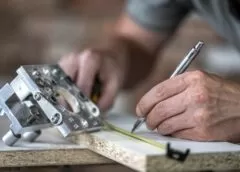Everyone loves to do certain activities in their spare time. Woodworking is such an enjoyable hobby to engage in that even those who do it for a living will also take it on as a pastime. Anyone who loves to work with wood will benefit from reading the tips below.
Woodworking can be expensive. The actual wood is one of the most costly parts of any project. The rest of the cost is usually labor, glue, and hardware. Sometimes you can save some money by buying a cheaper grade of wood for areas of your project that are not visible. Areas like drawers, backs, and bottoms are excellent places to use this wood.
You can use tape to catch excess glue. To prevent glue stains along joints, try clamping pieces together without bond. You put a video on your joint and then cut along it using a sharp blade. Separate your works, and then apply glue. After that, clamp them to each other again. Your glue will ooze on the tape instead of the wood. You can peel off the tape before your glue dries.
When working with wood, it is essential that you have much patience for the finishing process. This is just as important as the actual woodworking. Things like gluing edges and sanding the wood down take time, and you will only mess things up if you try to rush through this process.
Check out your local library for books on woodworking. You will likely find books that contain tips, special skills, or even step-by-step guides that can take you from start to finish on a project. A library can be an excellent source of information that people tend to forget when looking for knowledge, so do not let this resource slip your mind.
Always remember the rule of measuring twice and cutting once. You are human, which means that mistakes are inevitable. However, you can prevent measurement mistakes from turning into cutting errors when measuring two or three times. That will spare you severe waste, not just in terms of wasted wood, but also money and time.
There is a relatively easy solution if you find rust on your woodworking tools. As long as the rust is just on the surface, all you need to do is use a pumice stone on the spot. Be sure to scrub gently, as being too rough can lead to you damaging the tool itself.
Always clean up sanding dust thoroughly before staining or applying a topcoat. If you want a smooth finish, dust is your enemy. Use a vacuum over blowing dust into the air because it settles back onto the wood, and use a damp cloth to ensure all dust is removed from the wood in your final cleanup before staining or applying a topcoat.
Never cut any pieces of wood without checking for nails, screws, and other metal. While donning a pair of goggles keeps your eyes protected, you are still at risk for other injuries. Inspect every piece of wood, whether you are re-purposing it or using new lumber. With this safety tip, you are better safe than sorry, and checking the boards only takes a few minutes of your time.
Always wear the proper safety gear when you are working with wood. This includes eye protection, gloves, and earplugs with an electric saw when cutting wood. You should also wear a dust mask to avoid inhaling little pieces of wood. Keep this gear handy, so you always remember to use it.
Try using a mechanical pencil instead of other varieties when opting for a pencil. Mechanical pencils allow you to make more precise lines on your wood. This means more accurate cutting and fewer mistakes down the road. Even choose mechanical pencils over pencils that are labeled carpenter’s pencils. They are still more precise.
When you are getting ready to glue wood together, prepare some packing tape to help you secure the wood. Packing tape is a great way to tighten up those joints to perfect the glue sets. Pre-cut the packing tape to have it handy the minute you need it.
A good woodworker knows his wood. It would help if you familiarized yourself with things, such as the difference between softwood and hardwood. Learn the different kinds of grain and what types of wood are best for indoor and outdoor use. It is also wise to know about the cost of different wood types. Cost can affect your decision about which wood you will choose for a project.
When using a water-based stain or finish to raw wood, it is good to raise the grain first. Apply water to the surface just before the final sanding and wait until it dries. The wood fibers will stand, and you can remove them with minimal sanding before applying the finish.
Be sure that your woodworking power tools are in tip-top shape before you begin working. Your saw blades and drill bits should be perfectly sharp and appropriately installed. If you try to use a saw blade or drill bit that is dull or slightly askew, you will run into potentially dangerous problems. Additionally, using less than optimal equipment can only detract from the efficiency and accuracy of your work.
Keep a folder of anything that inspires you. If you see a staircase in a magazine or a bed frame in a catalog, clip them and keep them in a folder for future projects. You’ll have a folder chock full of great ideas when you want to start a new project.
Conclusion:
These tips have provided you with much knowledge you likely haven’t heard about before. Thanks to reading this article, you now have some ideas to help you better your work. The results will be astounding, and you will be so please with how much your skills progress.




